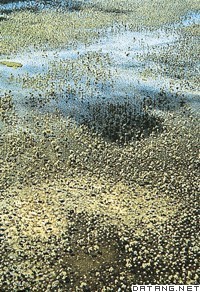2) Vegetation restoration models


植被恢复模式
1.
Effects of different vegetation restoration models on soil anti-erodibility in loess hilly area
不同植被恢复模式对黄土丘陵区土壤抗蚀性的影响
3) vegetation restoration


植被恢复
1.
Classification of typical degraded ecosystems at different stages of vegetation restoration:A case study in Xiaolangdi hilly areas,Henan Province,China;
典型退化山地生态系统植被恢复阶段分类——以小浪底库区山地为例
2.
Review of researches in vegetation restoration of freeway slopes;


高速公路边坡植被恢复研究进展
3.
Basic characters of soil seed bank and measures of vegetation restoration in rock desertification area in southwest of Guangxi;
桂西南石漠化山地土壤种子库的基本特征及植被恢复对策
4) revegetation
[,ri:vedʒi'teiʃən]


植被恢复
1.
Evaluation model for revegetation potentiality of sand dust sources in farming-pastoral ecotone in Northern China;
北方农牧交错带沙尘源植被恢复潜力评价模型研究
2.
Application of soil seed bank in wasteland revegetation project;


土壤种子库在荒废地植被恢复工程中的应用
3.
Web-GIS and RS based spatial decision support system for revegetation in coal mine waste area;
基于Web-GIS和RS的煤矿废弃地植被恢复空间决策支持系统
5) vegetation rehabilitation


植被恢复
1.
Spatial characteristics of vegetation rehabilitation in landscape boundary;


农田-草原景观界面中植被恢复的空间特征
2.
Barriers and countermeasures to them in vegetation rehabilitation in hilly and gully regions of the Loess Plateau located in North Shaanxi——A case study of Zichang County;
陕北黄土高原丘陵沟壑区植被恢复中的障碍分析与应对策略——以子长县为例
3.
Effects of vegetation rehabilitation on soil saturated hydraulic conductivity in Ziwuling Forest Area
子午岭植被恢复对土壤饱和导水率的影响
6) vegetation recovery


植被恢复
1.
Effects of vegetation recovery practices on the characteristics of soil nematode communities on seriously degraded grasslands in Songnen Plain.;
植被恢复方式对松嫩草原重度退化草地土壤线虫群落特征的影响
2.
The influence of vegetation recovery on organic carbon and nitrogen distribution in surface soil particle of dry area;
植被恢复对旱区表土颗粒中有机碳和氮分布的影响
3.
Vegetation recovery in subtropical monsoon evergreen broad-leaved forest Ⅰ. Gas exchange of woody legumes.;
亚热带季风常绿阔叶林植被恢复Ⅱ.──木本豆科植物的气体交换
补充资料:沼泽植被
| 沼泽植被 swamp vegetation 生长在土壤过湿或常年积水条件下,多年生沼生植物占优势的植被类型。属隐域性植被。以草本为主。区系组成较复杂,主要由莎草科、禾本科、蔷薇科、菊科、杜鹃花科等种类组成。为水生植物与陆生植物间的过渡类型。大部分沼泽植物有发育良好的通气组织,植物的根没于水中或湿透的土壤中,而带叶的茎挺出水面。按组成植被优势种的生活型可分为草本沼泽、泥炭沼泽和木本沼泽。①草本沼泽。典型的低位沼泽,由地表水或地下水补给,苔草及禾本科植物占优势。②泥炭沼泽,又称高位沼泽。由雨水补给,营养贫乏、寒冷,主要分布于北方针叶林带,泥炭藓成为优势植物,也有少数草本、低矮灌木及乔木,如越橘、落叶松等。③木本沼泽,又称中位沼泽。由雨水与地表水混合补给,在北半球森林带、森林冻原亚带、冻原带分布最广。中国的沼泽植被在青藏高原的若尔盖和东北三江平原较为集中,以草本沼泽为主,种类组成较简单。
|
说明:补充资料仅用于学习参考,请勿用于其它任何用途。
参考词条
